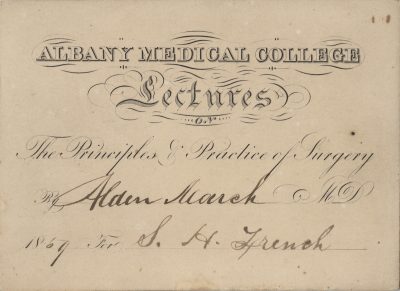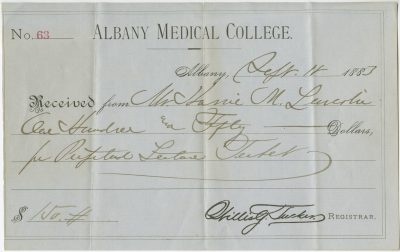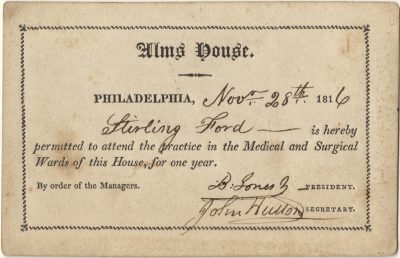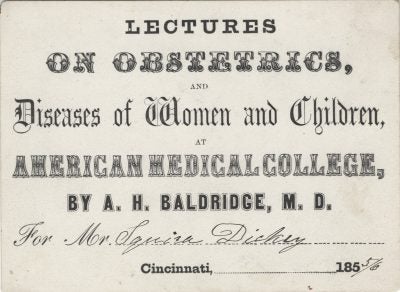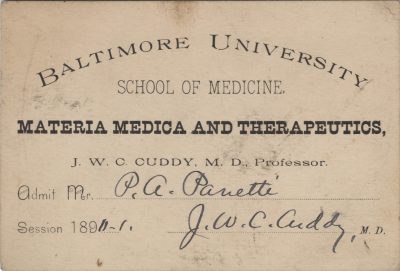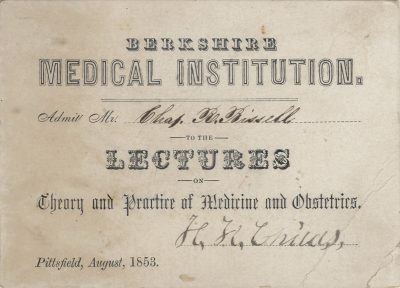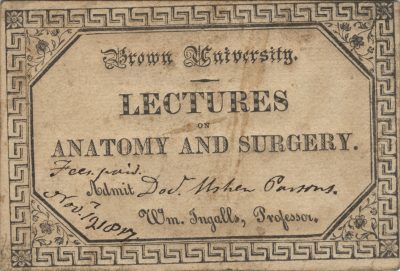1. Albany Medical College
|
Albany Medical College 1859 March, Alden, MD French, S. (Salphronius) H. Surgery |
|
|
March received his initial medical education under the tutelage of his brother, Davis, an Army surgeon. He attended medical lectures in Boston and received his medical degree from Brown University (M1820). In 1825 March began a decade of teaching at the Vermont Academy of Medicine in Castleton. Two years into this post, March, along with two Albany professors started offering supplemental medical instruction in that city. “Dr. March’s Practical School of Anatomy and Surgery” struggled by the mid-1830s. March and brother-in-law James H. Armsby, MD garnered public support resulting in the 1839 charter for Albany Medical College. March also helped establish Albany Hospital in 1849. French (Albany; M1859) previously attended the College of Physicians and Surgeons, University of the State of New York (14, 15). Soon after graduation he joined the 109th New York Volunteers as assistant surgeon. He served as health officer of Amsterdam, NY, and president of the Amsterdam Savings Bank.
Manning, James Hilton. Century of American Savings Banks. NY: B.F. Buck & Company, 1917. 158-59.
Norwood, William Frederick. Medical Education in the United States before the Civil War. Phila: University of Pennsylvania Press, 1944. 211-15. |
|
2. Albany Medical College
| Albany Medical College 1883 Tucker, Willis G. (registrar) Lincoln, Harrie, M. Perpetual ticket receipt |
|
|
In 1883 Albany Medical College’s fees and expenses for two full courses of lectures, matriculation, dissection and graduation cost $300. Of that, students paid $100 for each year of two years of lectures. Alternatively, the College offered a perpetual ticket for $150, which saved the medical students $50 and gave them unlimited access to future courses. Lincoln (Albany; M1886), who wrote his graduation thesis on Diphtheria, served as town supervisor and health officer of Wilton, NY in the early 1890s. Albany Medical College Archives, Alumni Records.
Catalogue of the Albany Medical College, Medical Department of Union University, 52nd Session, 1882-1883, and Announcement for Session, 1883-84. Albany, NY: Chas. Van Benthuysen & Sons, 1883. 9-10. |
|
3. Alms House of Philadelphia (Philadelphia Hospital/Philadelphia General Hospital, discontinued)
| Alms House of Philadelphia (Philadelphia Hospital/Philadelphia General Hospital, discontinued) 1816 Jones, B. (president) and Hutton, John (secretary) Ford, Stirling Hospital privileges |
|
|
The Philadelphia Almshouse opened in 1732 to house, feed and provide medical care for the city’s impoverished citizens. In 1772 the board of managers permitted medical students to attend the Almshouse. In 1816 that privilege cost $10. When the Almshouse moved from the city’s historic core to West Philadelphia in 1832, it became known as Blockley Almshouse and its new hospital on the grounds was called Philadelphia Hospital. Penn had an intermittent relationship with Philadelphia Hospital until the University relocated to adjacent property in West Philadelphia in the 1870s. From that time forward through its years as Philadelphia General Hospital until its closing in 1977, this institution supplemented the clinical training of medical students from Penn, as well as those from the city’s other medical schools. Ford (Penn; M1819) of Virginia was among the minority of his Southern colleagues willing to treat free or enslaved African Americans.
Croskey, John Welsh, MD. History of Blockley: A History of the Philadelphia General Hospital Since Its Inception, 1731-1928. Phila: F.A. Davis and Company, 1929. 15-30.
History Engine: Tools for Collaborative Education & Research, “Race and Medical Care.” The University of Richmond, 2008-2009. http://historyengine.richmond.edu/episodes/view/3621 |
|
4. American Medical College of Cincinnati (Eclectic Medical Institute of Cincinnati, discontinued)
| American Medical College of Cincinnati (Eclectic Medical Institute of Cincinnati, discontinued) 1855-56 Baldridge, A. H., MD Dickey, Squier Obstetrics and diseases of women and children |
|
|
Incorporated in 1853 and four years later merged into the Eclectic Medical Institute of Cincinnati (1845-1939), the American Medical College was one of several eclectic medical schools founded in mid-19th-century Cincinnati. In fact, before 1860, three out of the nation’s 13 colleges organized as eclectic or a mixture of eclectic and physio-medical were located in Cincinnati. Only the Eclectic Medical Institute of Cincinnati attained longevity. Eclectic medicine, which relied heavily on botanical remedies, emerged in the mid-19th century along with other branches of alternative medicine in reaction to the excesses and limited success of allopathic medical practices. Students at the American Medical College had privileges at the Commercial Hospital of Cincinnati, created in part by the efforts of allopath and medical education reformer, Daniel Drake, MD (Penn; M1816). Baldridge served on the original faculty roster of the Eclectic Medical Institute of Cincinnati. An Historical Sketch of the Eclectic Medical College, 1845-1911. http://www.henriettes-herb.com/eclectic/bios/bios-emi.html
Haller, John S. A Profile in Alternative Medicine: The Eclectic Medical College of Cincinnati, 1845-1942. Kent, Ohio: Kent State University Press, 1999. 19-20. |
|
5. Baltimore University School of Medicine (discontinued)
|
Baltimore University School of Medicine (discontinued) 1890-91 Cuddy, J.W.C., MD Panetti, Philip A. Materia medica, therapeutics and clinical medicine |
|
|
The Baltimore University School of Medicine existed from 1884 to 1905. Competition from many Baltimore medical schools, including The Johns Hopkins (opened in 1893), likely made it hard for all of them to survive. Cuddy joined the Baltimore faculty as professor of theory and practice and clinical medicine in 1887. He also served as chief of clinic and lecturer on principles and practice of medicine. A man of standing in his specialty, Cuddy presented a paper on “The Present Status of Materia Medica and Therapeutics” at the 1891 meeting of the American Medical Association. Panetti attended Baltimore University School of Medicine, but graduated from the University of Louisville in 1892. He served as assistant professor of chemistry in the University of Baltimore, 1894-95, and practiced medicine in Baltimore for six years. Panetti moved to Hustisford, Wisconsin, where he worked as a medical examiner for several life insurance companies and maintained a large general practice.
Baltimore University School of Medicine. http://mdhistoryonline.net/mdmedicine/index.cfm?action=search&type=schools&id=1
Cordell, Eugene Fauntleroy, MD. University of Maryland, 1807-1907, Its History, Influence, Equipment and Characteristics. Vol. 2. NY, Chicago: Lewis Publishing Company, 1907. 23. Cuddy, J.W.D., AM, MD. “THE PRESENT STATUS OF MATERIA MEDICA AND THERAPEUTICS. Read before the Section of Materia Medica and Pharmacy at the Forty-second Annual Meeting of the American Medical Association, at Washington, D. C., May, 1891.” JAMA. 1891; XVII(17):620-623. Hubbell, Homer Bishop. Dodge County, Wisconsin, Past and Present. Vol. 2. Chicago: The S.J. Clarke Publishing Company, 1913. 178-79. Shepherd, Henry Elliott. History of Baltimore, Maryland, from Its Founding as a Town to the Current Year, 1729-1898. Uniontown, PA: S.B. Nelson, 1898. 731. |
|
6. Berkshire Medical Institution (discontinued)
|
Berkshire Medical Institution (discontinued) 1853 Childs, Henry Halsey, MD Bissell, Charles R. Medicine and obstetrics |
|
| With a bachelors and masters degree from Williams College, Childs studied medicine under the tutelage of his father, a Revolutionary War surgeon. In 1823 he helped found the Berkshire Medical Institution, which commenced in a loose affiliation with Williams College as its medical department. It became an independent medical school in 1837, at which time Childs began his tenure as president, serving until 1863. Childs also lectured at medical schools at Woodstock, VT, and at Willoughby and Columbus, Ohio, and held the post of lieutenant governor of Massachusetts (1843). Attendance at Berkshire Medical College, as it came to be known, peaked in the 1840s; the school awarded 1,138 medical degrees before closing in 1869, the year after Childs’ death.
Kelly, Howard A. and Walter L. Burrage. American Medical Biographies. Baltimore: The Norman Remington Company, 1920. 216.
Norwood, William Frederick. Medical Education in the United States before the Civil War. Phila: University of Pennsylvania Press, 1944. 211-15. |
|
7. Boston City Hospital (Boston Medical Center)
| Boston City Hospital (Boston Medical Center) 1865 Cutler, Lucius A. (superintendent) Perry, E.E. (Edward Everett) Hospital privileges |
|
|
Boston City Hospital opened in 1864 in the South End to serve the city’s poor. From its beginning, the hospital also offered clinical instruction for medical students in clinics, on the wards and in “public” operations, and a highly competitive position of house officer. The physicians in attendance, Drs. Fitch Edward Oliver and John P. Reynolds, as well as the surgeons in attendance, Drs. D. McB. Thaxter and Charles Dudley Homans, were Harvard medical graduates and/or instructors. Perry (Harvard; M1868) practiced for six years prior to his death in 1875. In 1996 Boston City Hospital merged the Boston University Medical Center Hospital to form the Boston Medical Center.
Catalogue of the Officers and Students of Harvard University for the Academical [sic] Year 1859-60. Cambridge: Sever and Francis, 1859.
Cheever, David W., MD, George W. Gay, MD, A. Lawrence Mason, MD, and J. Bapst Blake, MD. A History of the Boston City Hospital from Its Foundation until 1904. Boston: Municipal Printing Office, 1906. |
|
8. Brown University
| Brown University 1817 Ingalls, William, MD Parsons, David Usher Anatomy and surgery |
|
|
Ingalls (Harvard; M1801) taught at Brown from 1811, the year of the Medical School’s founding, to 1823. Samuel D. Gross, MD credited Ingalls as the first US surgeon to amputate at the shoulder joint for gunshot injury (1813). Parsons received his license to practice medicine from the Massachusetts Medical Society in 1812, after studying with two preceptors. During the War of 1812 he served on the US Frigate Lawrence at the battle of Lake Erie under Commodore Hazard Perry. For his heroics as a surgeon under cannon fire, Congress awarded him a commendation and a monetary prize. Parsons used the latter to pay off debts accrued for his medical training. After the war Parsons pursued more formal medical education, attending lectures at Brown University in 1817, and the following year receiving a medical degree from Harvard. He held professorships in anatomy and physiology at both Brown and Dartmouth.
Kelly, Howard A. and Walter L. Burrage. American Medical Biographies. Baltimore: The Norman Remington Company, 1920. 592, 890-893.
|
|

